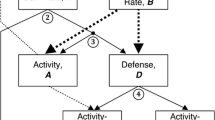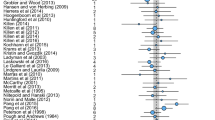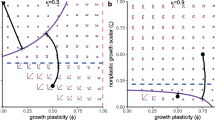Abstract
A lack of consensus on the general adaptive significance of energetic efficiency can be shown to exist in ecology and anthropology. After briefly reviewing key studies in optimal foraging theory and ecological anthropology, a model is presented which includes the following elements: (1) an equation of adaptive success with reproductive fitness, within an optimality framework; (2) a definition of energy limitation consistent with this framework; (3) a distinction between efficiency of energy capture and efficiency of energy use in achieving other goals; (4) a multiple definition of energetic efficiency that distinguishes purely energetic measures (output/input) from rate measures (energy captured per unit time); (5) the inclusion of time budgeting as a primary adaptive constraint; (6) a quantitative demonstration that increased output/input ratios do not consistently predict an increase in net energy captured, and are poor measures where time is a constraint. The general conclusion is that where energy is limiting, increased efficiency in the rate of energy capture will be adaptive because more net energy will be made available; where energy is not limiting, an increased net capture rate may still confer increased adaptive success, since time and labor energy are freed from energy-capture activities and can be devoted to achieving other adaptive goals. But while energetic efficiency, properly defined, is shown to have general adaptive significance in all cases where time or energy are constraints, considerations of adaptive optimality preclude the general equation of energetic efficiency and adaptive success.
Similar content being viewed by others
References
Alland, A. (1975). Adaptation.Annual Review of Anthropology 4: 59–73.
Alland, A., and McCay, B. (1973). The concept of adaptation in biological and cultural evolution. In Honigman, J. (ed.),Handbook of Social and Cultural Anthropology. Rand-McNally, Chicago, pp. 143–178.
Brookfield, H. C. (1972). Intensification and disintensification in Pacific agriculture: A theoretical approach.Pacific Viewpoint 13: 30–48.
Brown, J. L. (1964). The evolution of diversity in avian territorial systems.Wilson Bulletin 76: 160–169.
Brown, J. L., and Orians, G. H. (1970). Spacing patterns in mobile animals.Annual Review of Ecology and Systematics 1: 239–262.
Caraco, T., and Wolf, L. (1975). Ecological determinants of group sizes of foraging lions.American Naturalist 109: 343–352.
Charnov, E. L. (1976a). Optimal foraging: Attack strategy of a mantid.American Naturalist 110: 141–151.
Charnov, E. L. (1976b). Optimal foraging: The marginal value theorem.Theoretical Population Biology 9: 129–136.
Cody, M. L. (1974). Optimization in ecology.Science 183: 1156–1164.
Colinvaux, P. A. (1973).Introduction to Ecology. Wiley, New York.
Cottrell, F. (1955).Energy and Society. McGraw-Hill, New York.
Durham, W. H. (1976a). Resource competition and human aggression: A review of primitive war.Quarterly Review of Biology 51: 385–415.
Durham, W. H. (1976b). The adaptive significance of cultural behavior.Human Ecology 4: 89–121.
Dyson-Hudson, R., and Smith, E. A. (1978). Human territoriality: An ecological reassessment.American Anthropologist 80: 21–41.
Emlen, J. M. (1966). The role of time and energy in food preferences.American Naturalist 100: 611–617.
Emlen, J. M. (1973).Ecology: An Evolutionary Approach. Addison-Wesley, Reading, Mass.
Hamilton, W. J., III, and Watt, K. E. F. (1970). Refuging.Annual Review of Ecology and Systematics 1: 263–286.
Harpending, H., and Davis, H. (1977). Some implications for hunter-gatherer ecology derived from the spatial structure of resources.World Archaeology 8: 275–283.
Harris, M. (1968).The Rise of Anthropological Theory. Crowell, New York.
Harris, M. (1975).Culture, People, Nature. Crowell, New York.
Horn, H. S. (1968). The adaptive significance of colonial nesting in the Brewers Blackbird (Euphagus cyanocephalus). Ecology 49: 682–694.
Jochim, M. A. (1976).Hunter-Gatherer Subsistence and Settlement. A Predictive Model. Academic Press, New York.
Kozlovsky, D. G. (1968). A critical evaluation of the trophic level concept. I. Ecological efficiencies.Ecology 49: 48–60.
Lack, D. (1968).Ecological Adaptations for Breeding in Birds. Methuen, London.
Lee, R. B. (1968). What hunters do for a living, or, how to make out on scarce resources. In Lee, R. B., and DeVore, I. (eds.),Man the Hunter. Aldine, Chicago, pp. 30–48.
Lee, R. B. (1969). !Kung Bushman subsistence: An input-output analysis. In Vayda, A. P. (ed.),Environment and Cultural Behavior. Natural History Press, Garden City, N.Y., pp. 47–79.
Lee, R. B. (1972). !Kung spatial organization: An ecological and historical perspective.Human Ecology 1: 125–147.
Lewontin, R. C. (1970). The units of selection.Annual Review of Ecology and Systematics 1: 1–18.
Little, M. A., and Morren, G. E. B., Jr. (1976).Ecology, Energetics, and Human Variability. W. C. Brown, Dubuque, Iowa.
Lotka, A. J. (1922). Contributions to the energetics of evolution.Proceedings of the National Academy of Sciences (U.S.A.) 8: 147–188.
MacArthur, R. H. (1972).Geographical Ecology. Harper and Row, New York.
MacArthur, R. H., and Pianka, E. R. (1966). On optimal use of a patchy environment.American Naturalist 100: 603–609.
Marshall, L. (1968). Discussion. In Lee, R. B., and DeVore, I. (eds.),Man the Hunter. Aldine, Chicago.
McNab, E. K. (1963). Bioenergetics and the determination of home range size.American Naturalist 97: 133–140.
Morren, G. E. B. (1977). From hunting to herding: Pigs and the control of energy in montane New Guinea. In Bayliss-Smith, T. P., and Feachem, R. G. (eds.),Subsistence and Survival, Rural Ecology in the Pacific. Academic Press, New York, pp. 273–315.
Odum, E. P. (1971).Fundamentals of Ecology. 3rd ed. Saunders, Philadelphia.
Odum, H. T. (1971).Environment, Power, and Society. Wiley, New York.
Odum, H. T. (1974). Energy, ecology and economics.CoEvolution Quarterly 1: 8–16.
Odum, H. T., and Odum, E. C. (1976).Energy Basis for Man and Nature. McGraw-Hill, New York.
Orians, G. H. (1971). Ecological aspects of behavior. In Farner, D., and King, J. (eds.),Avion Biology, Vol. 1. Academic Press, New York, pp. 513–546.
Perlman, S. M. (1976).Optimum Diet Models and Prehistoric Hunter-Gatherers: A Test on Martha's Vineyard. Ph.D. thesis, University of Massachusetts, Amherst.
Pianka, E. R. (1974).Evolutionary Ecology. Harper and Row, New York.
Pyke, G. H., Pulliam, H. R., and Charnov, E. L. (1977). Optimal foraging: A selective review of theory and tests.Quarterly Review of Biology 52: 137–154.
Rappaport, R. A. (1968).Pigs for the Ancestors. Yale University Press, New Haven.
Rappaport, R. A. (1971). The flow of energy in an agricultural society.Scientific American 224(3): 116–132.
Rapport, D. J. (1971). An optimization model of food selection.American Naturalist 105: 575–588.
Richerson, P. J. (1977). Ecology and human ecology: A comparison of theories in the biological and social sciences.American Ethnologist 4: 1–26.
Ricklefs, R. E. (1973).Ecology. Chiron Press, Newton, Mass.
Rogers, E. S., and Black, M. B. (1976). Subsistence strategy in the fish and hare period, Northern Ontario: The Weagamow Ojibwa, 1880–1920.Journal of Anthropological Research 32: 1–43.
Royama, T. (1970). Factors governing the hunting behavior and selection of food by the great tit (Parus major L.). Journal of Animal Ecology 39: 619–668.
Sahlins, M., and Service, E. (eds.). (1960).Evolution and Culture. University of Michigan Press, Ann Arbor.
Schoener, T. W. (1968). Sizes of feeding territories among birds.Ecology 49: 123–141.
Schoener, T. W. (1969). Models of optimal size for solitary predators.American Naturalist 103: 277–313.
Schoener, T. W. (1971). Theory of feeding strategies.Annual Review of Ecology and Systematics 2: 369–404.
Slobodkin, L. B. (1968). How to be a predator.American Zoologist 8: 43–51.
Slobodkin, L. B. (1972). On the inconstancy of ecological efficiency and the form of ecological theories.Transactions of the Connecticut Academy of Sciences 44: 291–305.
Slobodkin, L. B. (1974). Prudent predation does not require group selection.American Naturalist 108: 665–678.
Smith, C. C. (1968). The adaptive nature of social organization in the genus of tree squirrels Tamiascirius.Ecological Monographs 40: 349–371.
Smith, E. A. and Thomas, R. B. (n.d.). Energetic efficiency and adaptation. In Thomas, R. B., and Harris, L. D. (eds.),Energy Flow and Human Adaptation. In preparation.
Stern, J. T., Jr. (1970). The meaning of “adaptation” and its relation to the phenomenon of natural selection. In Dobzhansky, T., Hecht, M. K., and Steere, W. C. (eds.),Evolutionary Biology, Vol. 4. Appleton-Century-Crofts, New York, pp. 39–66.
Thomas, R. B. (1973).Human Adaptation to a High Andean Energy Flow System. Occasional Papers in Anthropology, No. 7, Department of Anthropology, Pennsylvania State University, University Park, Pennsylvania.
Truswell, A. S., and Hansen, J. D. L. (1976). Medical research among the !Kung. In Lee, R. B., and DeVore, I. (eds.),Kalahari Hunter-Gatherers. Harvard Univ. Press, Cambridge, pp. 166–194.
Tullock, G. (1971). The coal tit as a careful shopper.American Naturalist 105: 77–80.
Vayda, A. P., and McCay, B. J. (1975). New directions in ecology and ecological anthropology.Annual Review of Anthropology 4: 293–306.
White, L. A. (1949).The Science of Culture. Grove Press, New York.
White, L. A. (1959).The Evolution of Culture. McGraw-Hill, New York.
Williams, G. C. (1966).Adaptation and Natural Selection. Princeton University Press, Princeton, N.J.
Williams, G. C. (ed.). (1971).Group Selection. Aldine, Chicago.
Wilmsen, E. N. (1973). Interaction, spacing behavior, and the organization of hunting bands.Journal of Anthropological Research 29: 1–31.
Wilson, E. O. (1973). Group selection and its significance for ecology.BioScience 23: 631–638.
Winterhalder, B. P. (1977).Foraging Strategy Adaptations of the Boreal Forest Cree: An Evaluation of Theory and Models from Evolutionary Ecology. Ph.D. thesis, Cornell University, Ithaca, N.Y.
Winterhalder, B., Larsen, R., and Thomas, R. B. (1974). Dung as an essential resource in a highland Peruvian community.Human Ecology 2: 89–104.
Wobst, H. M. (1974). Boundary conditions for Paleolithic social systems: a simulation approach.American Antiquity 39: 147–178.
Wolf, L. L., Hainsworth, F. R., and Gill, F. B. (1975). Foraging efficiencies and time budgets in nectar-feeding birds.Ecology 56: 117–128.
Yellen, J., and Harpending, H. (1972). Hunter-gatherer populations and archaeological inference.World Archaeology 4: 244–253.
Author information
Authors and Affiliations
Rights and permissions
About this article
Cite this article
Smith, E.A. Human adaptation and energetic efficiency. Hum Ecol 7, 53–74 (1979). https://doi.org/10.1007/BF00889352
Issue Date:
DOI: https://doi.org/10.1007/BF00889352




